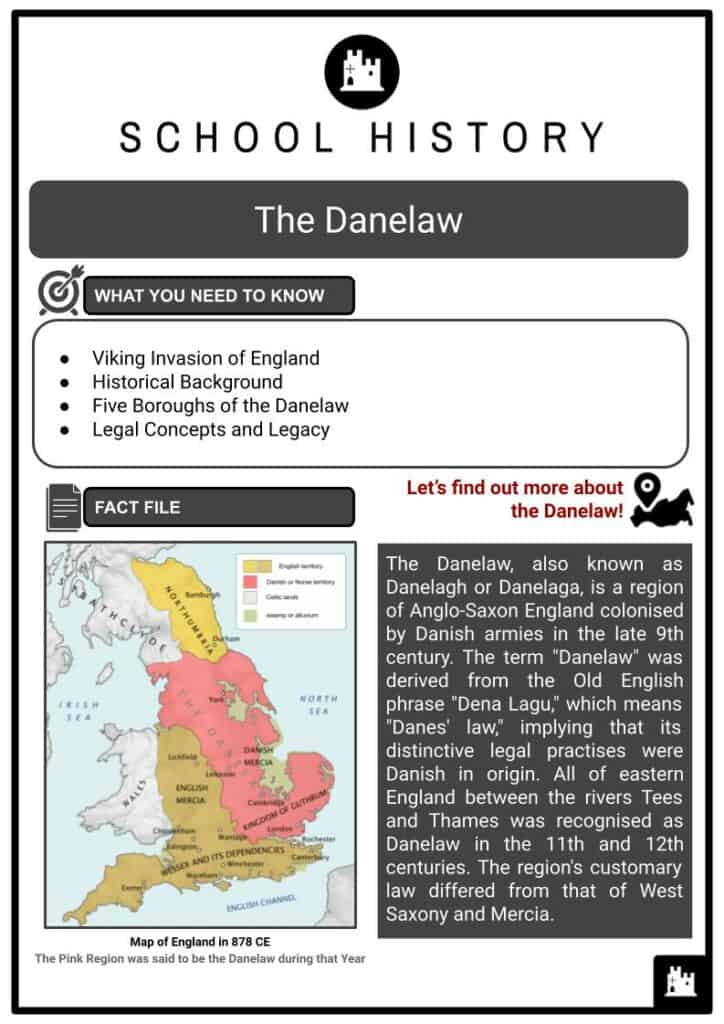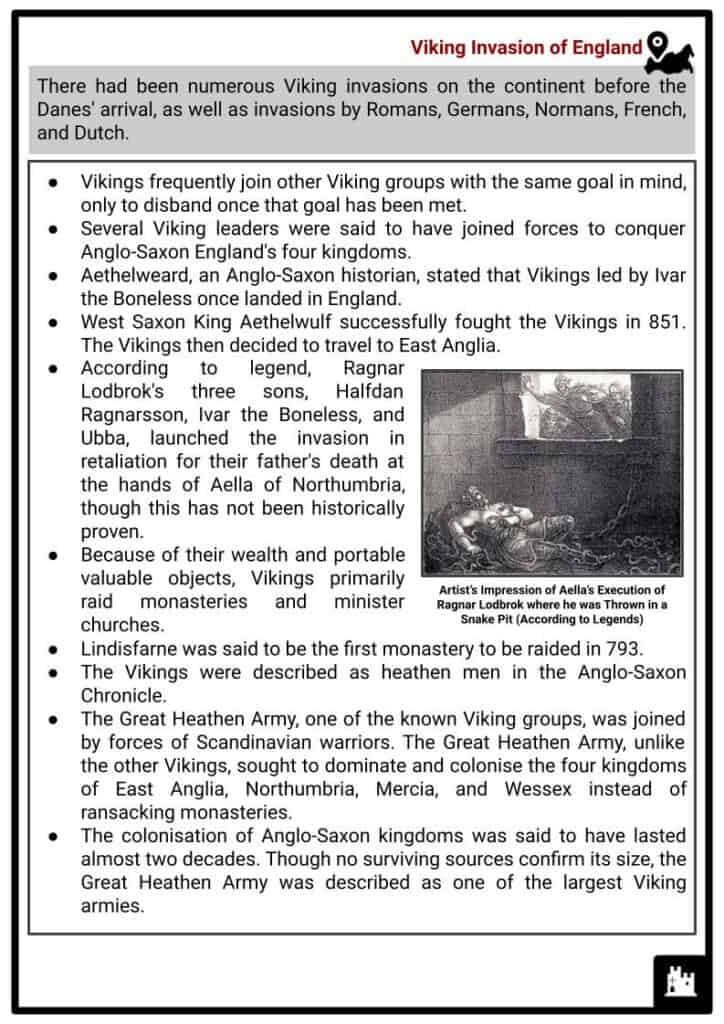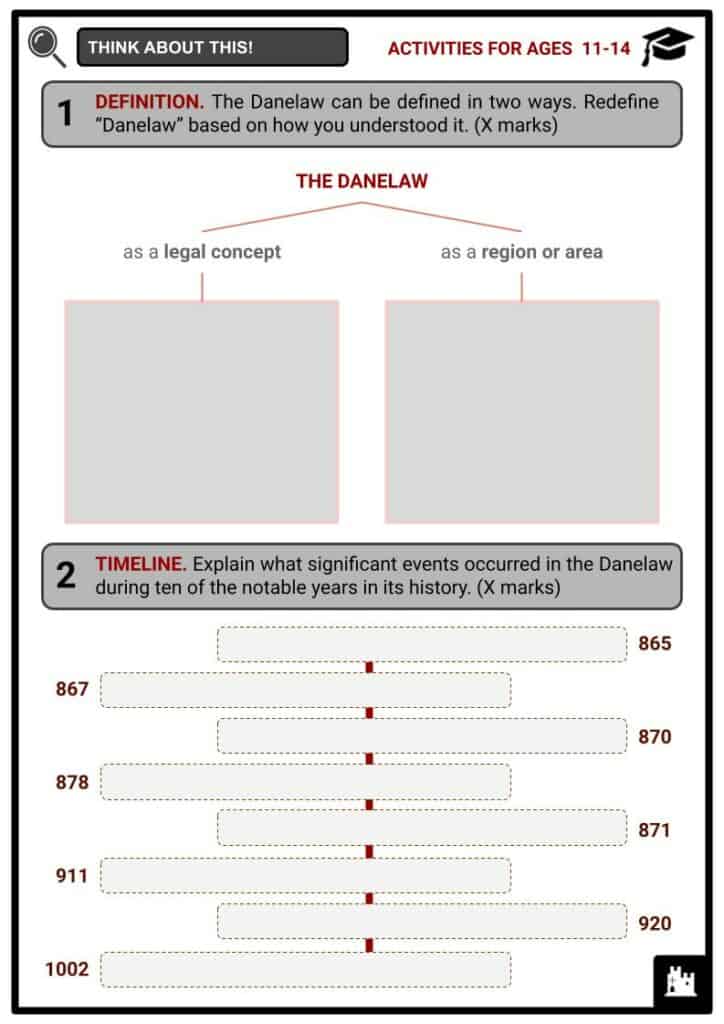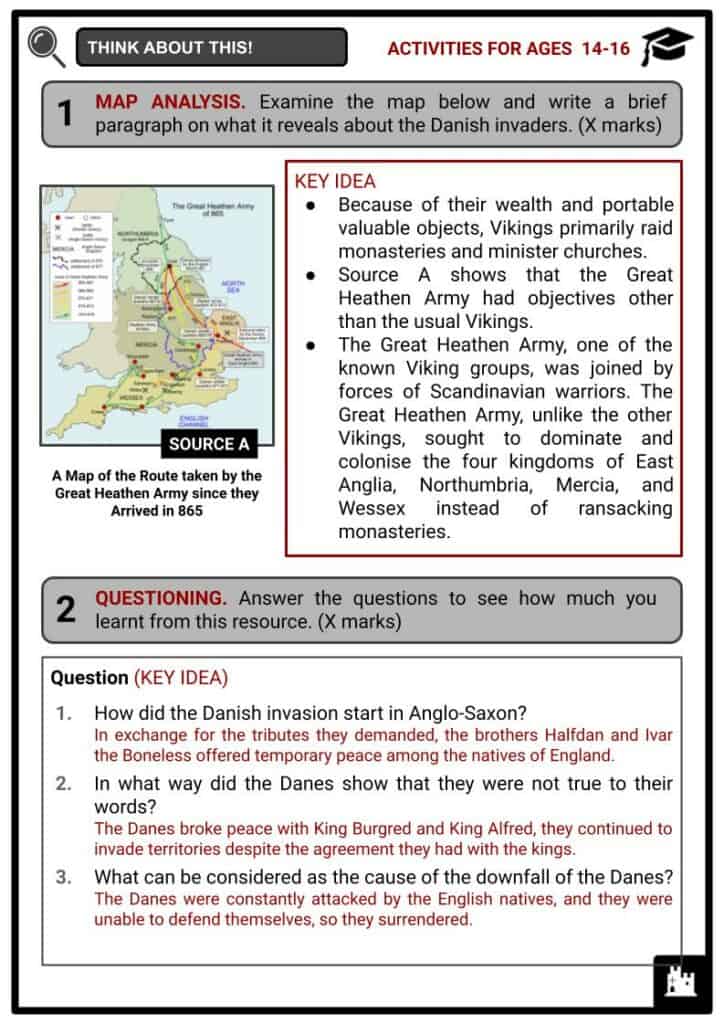The Danelaw Worksheets
Do you want to save dozens of hours in time? Get your evenings and weekends back? Be able to teach about The Danelaw to your students?
Our worksheet bundle includes a fact file and printable worksheets and student activities. Perfect for both the classroom and homeschooling!
Summary
- Viking Invasion of England
- Historical Background
- Five Boroughs of the Danelaw
- Legal Concepts and Legacy
Key Facts And Information
Let’s find out more about the Danelaw!
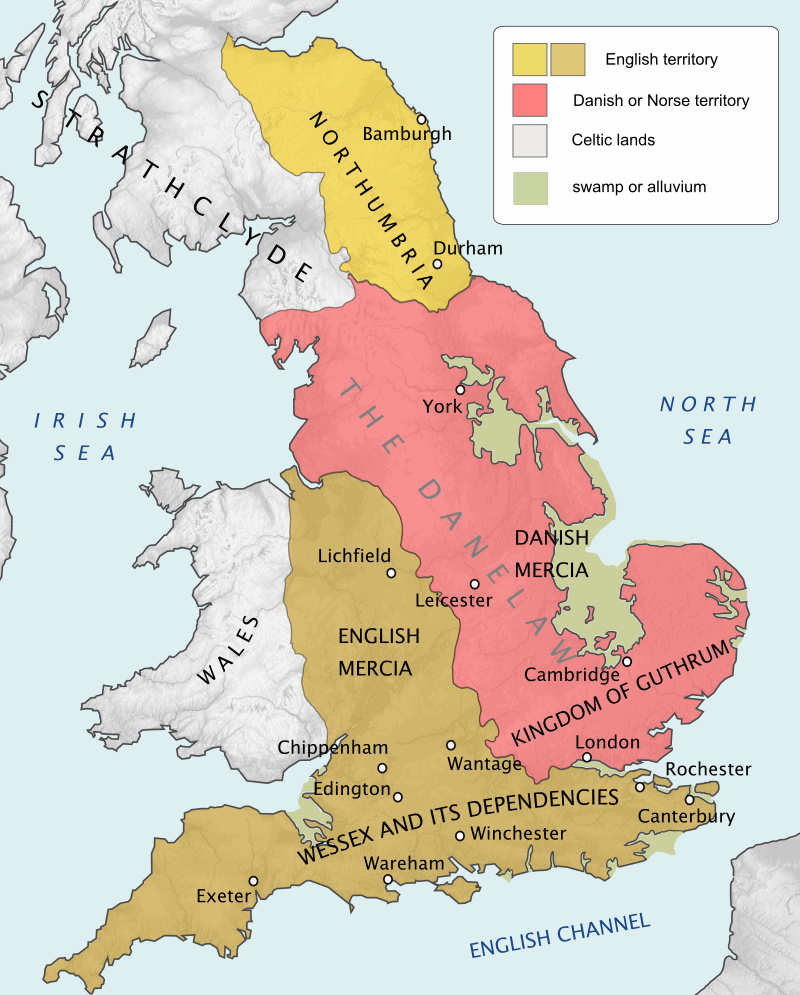
The Danelaw, also known as Danelagh or Danelaga, is a region of Anglo-Saxon England colonised by Danish armies in the late 9th century. The term "Danelaw" was derived from the Old English phrase "Dena Lagu," which means "Danes' law," implying that its distinctive legal practises were Danish in origin. All of eastern England between the rivers Tees and Thames was recognised as Danelaw in the 11th and 12th centuries. The region's customary law differed from that of West Saxony and Mercia.
Viking Invasion of England
- There had been numerous Viking invasions on the continent before the Danes' arrival, as well as invasions by Romans, Germans, Normans, French, and Dutch.
- Vikings frequently join other Viking groups with the same goal in mind, only to disband once that goal has been met.
- Several Viking leaders were said to have joined forces to conquer Anglo-Saxon England's four kingdoms.
- Aethelweard, an Anglo-Saxon historian, stated that Vikings led by Ivar the Boneless once landed in England.
- West Saxon King Aethelwulf successfully fought the Vikings in 851. The Vikings then decided to travel to East Anglia.
- According to legend, Ragnar Lodbrok's three sons, Halfdan Ragnarsson, Ivar the Boneless, and Ubba, launched the invasion in retaliation for their father's death at the hands of Aella of Northumbria, though this has not been historically proven.
- Because of their wealth and portable valuable objects, Vikings primarily raid monasteries and minister churches.
- Lindisfarne was said to be the first monastery to be raided in 793.
- The Vikings were described as heathen men in the Anglo-Saxon Chronicle.
- The Great Heathen Army, one of the known Viking groups, was joined by forces of Scandinavian warriors. The Great Heathen Army, unlike the other Vikings, sought to dominate and colonise the four kingdoms of East Anglia, Northumbria, Mercia, and Wessex instead of ransacking monasteries.
- The colonisation of Anglo-Saxon kingdoms was said to have lasted almost two decades. Though no surviving sources confirm its size, the Great Heathen Army was described as one of the largest Viking armies.
Historical Background
- The Danelaw began before the 9th century, when the Great Heathen Army invaded parts of England. Previously, the term only referred to the actual law that the invaders attempted to enforce. However, by the 11th century, it had come to refer to the area where the invaders enforced the law.
- Start of Danish Invasion
- There had been several Danish attacks on the British Isles' coastline since the early eighth century.
- Danish raider settlements in England began in 865.
- In exchange for the tributes they demanded, the brothers Halfdan and Ivar the Boneless offered temporary peace among the natives of England.
- The Danes vs King Osberht and Aella
- They advanced from East Anglia to the north and attacked Northumbria. Northumbria was embroiled in a civil war between King Osberht and Aella at the time. The Danish brothers who led the Great Heathen Army exploited the civil war to successfully capture York.
- The loss of York brought Osberht and Aella together to fight the Danish colonisers.
- In 867, the newly formed alliance launched a counter-attack, during which the Danes killed them both and installed a puppet king on the Northumbrian throne.
- Aethelred, King of Wessex, and his brother Alfred, fought the Danes, who refused to fight.
- The Danes in Peaceful Agreement with King Burgred of Mercia
- To avoid further wars, King Burgred of Mercia granted the Danes the Nottingham territory on the condition that they do not take the rest of Mercia.
- As a result of the agreement, Nottingham was already under Danish control by 868.
- The Danes vs. King Edmund
- In 869, Ivar the Boneless, one of the leaders, demanded tribute from East Anglia's King Edmund. The king declined to grant the request. When Ivar captured King Edmund at Hoxne in 870, it led to his defeat. East Anglia was thus added to the territories under Danish control.
- The Danes vs King Aethelred and Alfred
- King Aethelred and Alfred attacked the Danes again, but this time they were defeated, and the Danes decided to pursue them.
- On 7 January 871, the king of Wessex and his brother faced the Danish invaders.
- Under Alfred's command, the Battle of Ashdown was won over the Danes. Instead, the Danes retreated and built reinforcements at Basing. King Aethelred was defeated when he attacked the reinforcements.
- King Aethelred died on 23 April 871, and his brother succeeded him as King of Wessex. The first years of King Alfred's reign were spent attacking small isolated groups of Danes. He won minor victories against the Danes, but his army was on the verge of disintegrating. King Alfred, anticipating defeat, decided to make a peace treaty with the Danes.
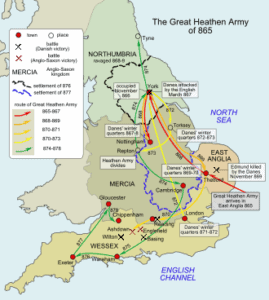
A Map of the Route taken by the Great Heathen Army since they Arrived in 865
- Ivar the Boneless Broke the Peace with King Burgred
- The Danes turned north and attacked Mercia, gaining control of London. King Burgred fought against Ivar and his army out of disappointment because they had previously agreed that the rest of Mercia would be spared except for Nottingham.
- The King of Mercia flew to Europe in 874. In contrast, Ivar died during his campaign against Mercia.
- After Ivar the Boneless died, a Guthrum the Old took his place. Guthrum defeated Burgred and installed a puppet on the throne of Mercia. Only Wessex was still resisting Danish control at this point.
- Peace with King Alfred Broke
- In 875, the Danes established a settlement in Dorset, which was part of King Alfred's kingdom.
- The peace that King Alfred promised took effect until it broke the following year when the Danes captured Wareham and Exeter.
- While the Danes awaited reinforcements from Scandinavia, King Alfred took the necessary steps to defend his kingdom.
- The Danes suffered a setback when reinforcements were delayed by a storm, forcing them to retreat and return to East Mercia.
- Guthrum led an attack on Wessex in January 878 to capture its king, Alfred.
- King Alfred Defeated the Danes
- Another Danish army arrived in South Wales and moved south to stop Alfred from escaping Guthrum's army. During their march, the new Danish army captured Countisbury Hill, led by Odda, a Wessex ealdorman.
- Odda's Saxons attacked the Danes while they were sleeping. They managed to defeat the superior forces and save Alfred.
- To avoid the other living superior Danish forces, Alfred hid in the Somerset marshes for the rest of the winter and spring of 878.
- Alfred was able to gather an army while hiding and attack Guthrum at Edington. This time, the Danes were defeated.
- The Danes Surrendered
- The Danes were constantly attacked by the English natives, and they were unable to defend themselves, so they surrendered.
- Alfred demanded that their defeat force Guthrum become a Christian. Guthrum agreed to Alfred's request in exchange for the King of Wessex as his godfather.
- Guthrum stayed in East Anglia for a while, but in 884, he attacked Kent and was defeated once more.
- The Treaty of Alfred and Guthrum established the boundaries of the Danelaw and allowed the Danes to rule themselves while in the region.
- Aethelwald Broke Peace with the Danes
- Essex was surrendered to Aethelwald in 902, who broke the East Anglian Danes' peace the following year.
- The English defeated the Danes in the Battle of Tettenhall on 911.
- Edward the Elder
- In 917, the Kingdom of Essex and East Anglia accepted Edward the Elder as their suzerain overlord on the promise of peace and protection.
- In 920, the people of Northumbria, including the Danes, recognised Edward as their father and lord.
- The Fade of the Danes
- The Danes lived in English territories peacefully, ruling themselves.
- But in 1002, when the St. Brice's Day massacre of the Danes occurred. The killings were ordered by King Aethelred II, the Unready.
- Sweyn II of Denmark led an army that landed in England in 1069 and took control of York after defeating the Norman garrison. King William's forces eventually defeated Sweyn's army.
- In 1075, one of Sweyn's sons, Knut, travelled to England to support an English rebellion, but the rebels were crushed even before he arrived, so he settled for plundering York instead and returning home.
- Knut ascended to the throne. In 1085, he planned a major invasion of England, but the army he expected did not arrive.
- Apart from Eystein II of Norway's attempt to plunder the east coast of England, there were no other serious Danish invasions or raids on England after this.
The Five Boroughs of the Danelaw
- The Treaty of Wedmore was formed after the Battle of Edington ended the war between Alfred's forces and Guthrum's army, in which Guthrum agreed to be baptised as a Christian, take the name Aethelstan, and leave Wessex. Boundaries were established, and the Danelaw began to emerge. Guthrum established the Kingdom of Guthrum in East Anglia, where he died. Five Danish armies ruled Danish Mercia in the east. The Danes established their laws and customs and divided their territory into five boroughs that would serve as the foundations of their political power.
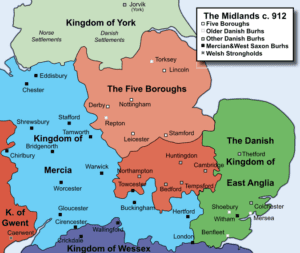
Location of the Five Boroughs of Danelaw - The Five Boroughs of Danelaw established five major towns: Derby, Leicester, Lincoln, Nottingham, and Stamford.
- The term "borough" is derived from the German word "burg," which means "castle." This reflects the structure of the towns, which are surrounded by walls that enclose and protect the residents from potential attacks.
- Each borough was ruled with the power to manipulate its lands while being required to respond to the overlords in the Jorvik, a kingdom created by the Vikings in York. This was referred to as Danish Jarldom.
- Nottingham
- Since 868, Vikings from the Great Heathen Army had been settling in Nottingham.
- The borough of Nottingham arose from Edward of Wessex's desire to fortify the settlement against possible Danae attacks. He established a buffer zone covering approximately 39 acres of land in Saxon Nottingham.
- Following a Norman conquest, the area fell out of use. The Danes saw it and built a settlement there, complete with a Town Hall and Law Courts.
- Derby
- Derby was settled by the Danes in 877 and was governed by Danelaw.
- The Danelaw ruling came to an end in 913, when a burh nearby launched an anti-Danish campaign.
- Lady Aethelflaed successfully attacked Derby in July 917, converting the area from Danish to English Mercia.
- Lincoln
- Lincoln became a strategic area due to its location on the route between Wessex and York.
- The isolated borough was safe from Anglo-Saxon and Danish Viking battles.
- The Danes took control of the area after selecting it as one of the five boroughs, but for some reason, they lost control of the territories on the border of Mercia and Wessex, which included this borough at Lincoln, in 918.
- Stamford
- Ealdorman Aethelnoth's attempts to abolish Danish control of the areas in West Saxon were unsuccessful in the area of Stamford, and the borough remained unaffected by attacks against the Danes.
- When King Edward attacked the area in May 918, however, the Danes were unable to defeat the army of Wessex and were forced to accept defeat.
- Leicester
- King Edward the Elder and Aethelflaed established a borough in Warwick and attempted an attack on the borough in Leicester. However, the borough faced threats.
- Until, in 918, when overwhelming forces had been attacking the Danes since the previous year, they were attacked by a Mercian army. The stronghold town finally surrendered to Aethelflaed's troops.
Legal Concepts and Legacy
- The "Danelaw" may refer to the actual law that the Danes implemented as part of their rule, not just as the region where the Danes peacefully settled in the Anglo-Saxon territory. Before the Norman conquest, they imposed some of their native legal concepts on parts of England. Some of these practises, along with other Danish influences, were retained in the lives of Anglo-Saxon natives, while others simply became part of history.
- The Danelaw was one factor that contributed to civilian peace in Anglo-Saxon and Viking communities.
- Legal arguments were used, such as the amount that should be paid when someone did something wrong.
- Vikings use the wapentake as a standard for dividing land where the Danelaw would be implemented.
- The judicial practise was said to have continued through the use of the execution site and cemetery.
- Following the implementation of the Danelaw, nearly half of the population in the countryside had the legal status of "sokeman".
- A person with the status of sokeman was subject to the jurisdiction of another person.
- They were in the position of being both a free tenant and a bond tenant.
- The peasants were given more rights.
- A sokeman became a free man under the jurisdiction of the lord.
- Despite the fact that the Anglo-Saxon natives successfully defended their territories against the Danes, the Scandinavian settlement's influence can still be seen in some parts of England. Place names that end in -howe, -by, or -throp are particularly indicative of this claim.
- Many words from the languages have been retained in the Danelaw, including the word law itself, sky and window, and third-person pronouns. Many other words persisted in northern England.
- Four among the five boroughs survived as county towns: Leicestershire, Lincolnshire, Nottinghamshire and Derbyshire. Stamford's survival may have been due to its proximity to the autonomous territory of Rutland.
Image Sources
- https://upload.wikimedia.org/wikipedia/commons/thumb/a/a6/England_878.svg/800px-England_878.svg.png
- https://upload.wikimedia.org/wikipedia/commons/thumb/3/35/England_Great_Army_map.svg/330px-England_Great_Army_map.svg.png
- https://upload.wikimedia.org/wikipedia/commons/thumb/9/97/Midland_Map_-_5_Boroughs_912_Ad.svg/675px-Midland_Map_-_5_Boroughs_912_Ad.svg.png

